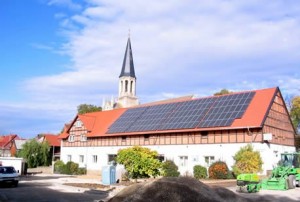Germany just broke its monthly solar power generation record once again. In July, the grey-skied country logged 5.1 terawatt hours (TWh) of electricity from solar power, slightly better than the 5 TWh of electricity generated by wind turbines it produced in January.
As Inhabitat points out, “The accomplishment proves once again that a lack of sunshine is no obstacle to scaling up solar energy — and if the Teutons can produce record amounts of solar power under grey skies, then the potential for countries with sunnier weather and more land mass (like the United States) is limitless.”
This recent milestone is one of many for the country that stands head and shoulders above the rest of the world in its rapid embrace of solar energy. As a point of comparison, Clean Technica notes, in terms of total solar power capacity per capita, Germany crushes every other country. At the end of 2012, it had approximately 400 MW of solar power capacity per million people, considerably more than #2 Italy at 267 MW per million people, #3 Belgium at 254 MW per million people, and #4 Czech Republic at 204 MW per million, and #5 Greece at 143 MW per million people. The US came it at #20 with about 25 MW per million people.
As Germany strives for a lofty goal of receiving 80 percent of its power from renewable sources by 2050, government subsidies are playing a big role in the rapid growth of renewable energy. Germany’s simple feed-in tariff policy, which pays renewable energy producers (e.g. solar energy producers) a set amount for the electricity they produce under long-term contracts, has driven the solar power boom. As installations continue to outpace government targets, Germany announced it will begin scaling back its feed-in tariff beginning this month.
Germany’s long-term policies to incentivize renewable energy have had a significant impact on reducing the “soft” costs associated with solar installation, such as permitting, inspection, interconnection, financing, customer acquisition. In fact, residential PV systems installed last year in Italy, Australia, and Germany are nearly 40 percent lower than in the U.S.
Soft costs represent approximately half of the total installed cost of residential solar systems here in the U.S., according to the National Renewable Energy Laboratory (NREL), but there are multiple options for reducing these and making solar power more accessible without the use of German-style long-term federal incentives.
America’s own German-style solar boom may be just around the corner. Residential solar installations in 2012 reached 488 megawatts — a 62 percent increase over 2011 installations. Jon Wellinghoff, chairman of the Federal Energy Regulatory Commission (FERC) recently told Greentech Media that solar is growing so quickly, “it could double every two years.” He continued that other renewable sources will supplement solar, “but at its present growth rate, solar will overtake wind in about ten years. It is going to be the dominant player. Everybody’s roof is out there.”
GTM Research predicts that “in the next 2 1/2 years the U.S. will double its entire cumulative capacity of distributed solar — repeating in the span of a few short years what it originally took four decades to deploy.”
This Commentary was originally published in Climate Progress (August 22, 2013), at thinkprogress.org/climate/2013/08/22/2508191/germany-solar-generation-record/
Sources:
Josh Marks, “Germany Shatters Monthly Solar Generation Record With 5.1 Terawatt Hours of Clean Energy,” inhabitat (August 20, 2013). inhabitat.com/germany-shatters-monthly-solar-power-generation-record-with-5-1-terawatt-hours-of-clean-energy/
Zachary Sahan, “Germany Breaks Monthly Solar Generation Record, ~6.5 Times More Than US Best,” Clean Technica (August 19, 2013). cleantechnica.com/2013/08/19/germany-breaks-monthly-solar-generation-record/
Stefan Nicoal, “German Solar Subsidy to Drop to Third of Japan’s on Installs,” Bloomberg (July 31, 2013). www.bloomberg.com/news/2013-07-31/german-solar-subsidy-to-drop-to-third-of-japan-s-on-installs.html
Matt Casper and Ryan Koronowski, “It Keeps Getting Cheaper To Install Solar Panels In The U.S.,” Climate Progress (Auust 13, 2013). thinkprogress.org/climate/2013/08/13/2455121/solar-getting-cheaper/
Bryan Lewis, “The Future Of US Solar Power: Opportunities In Soft Costs,” Climate Progress (July 24, 2013). thinkprogress.org/climate/2013/07/24/2345511/the-future-of-us-solar-power-opportunities-in-soft-costs/
“U.S. Solar Market Insight 2012 Year in Review,” Solar Energy Industries Association www.seia.org/research-resources/us-solar-market-insight-2012-year-review
Herman K. Trabish, “FERC Chair Jon Wellinghoff: Solar ‘Is Going to Overtake Everything’,” greentechgrid (August 21, 2013). www.greentechmedia.com/articles/read/ferc-chair-wellinghoff-sees-a-solar-future-and-a-utility-of-the-future



No comments yet, add your own below